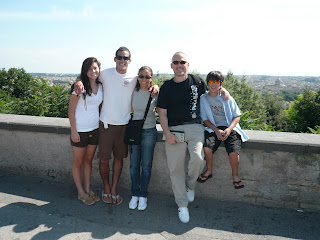
The Roman Emperors loved to haul back to Rome the great treasures of cultures more ancient than their own. Thus, the explanation for the dozens of Egyptian obelisks planted around the city. In turn, this concentration of antiquity's great art inspired Roman artists and craftsmen to their own heights of artistic creation. Nothing is more emblematic of the Popes as successors to the Roman Emperors than the Vatican Museums. They are filled with the great treasures of the Mediterranean and were to a great extent one of the catalysts for the Italian Renaissance which is obviously well represented here as well.
I warn you if you love art, do not try to do the Vatican Museums in one day. But if you are just curious about what all the fuss is about or want to learn more about the "best of the best" then put on your hiking shoes and prepare to move at a near jog through room after room, after courtyard, after hallway of what made the Renaissance such a big deal (according to every history teacher since the 1600s).
This is not a paid advertisement but one of the main reasons the Vatican Museums are at the top of our list is Professor Enrico Bruschini. He is available as a guide but if that doesn't work he has two wonderful books available on Amazon: In the Footsteps of Popes and The Vatican Masterpieces.
So what is the official Trinca list of the best-of-the best? (I warn you the list is long) First, Fra Angelico paintings -- another artist who seemed to anticipate modern painting; Raphael's Transfiguration painting which seems to out Michelangelo, Michelangelo; the shocking sketch/painting of St. Jerome by Leonardo da Vinci; Caravaggio in general, his Deposition specifically which is arguably his best; the many, many marble statues from antiquity (look how the Greek and Roman artists were able to express the shape of the human body even through clothing), the must-sees of which are the Hermes (a picture of which I will be taking to my next trainer), the Lacoon, the Belvedere torso (both of which influenced Michelangelo's Sistine Chapel paintings) and don't forget to look for the statue that is a dead ringer for President Bill Clinton (I kid you not); and one of the best Egyptian museums in the world.
But don't overlook the Gallery of Tapestries (notice how the perspective changes on the Christ Resurrection tapestry -- almost impossible to do in a painting let alone a woven tapestry); the Gallery of Maps (we were able to find the small town from where the Trincas emigrated). Prepare to spend time in the Raphael Stanze and pay particular attention to the School of Athens (see if you can spot the brooding Michelangelo and the Raphael self portrait. Finally, pay attention to the floors! Many of them are 2,000 year old mosaics -- yes they are originals torn out of many an emperor's palace.
Remember, the Vatican Museums are not a check-the-box sort of Rome experience. You could literally spend a lifetime studying and enjoying their contents. So, get your tickets on the internet ahead of time and go back more than once if you can.














